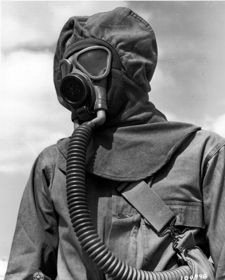Organizations Dedicated to the Nonproliferation of Chemical and Biological Weapons  Weapons of mass destruction, or WMDs, include chemical, biological, and nuclear weapons. While international efforts to control the proliferation of WMDs exist, the cooperation of signatory and non-signatory countries and non-governmental groups varies. The threat to national and international security from WMDs remains high, although arms control initiatives and decades of disarmament after the end of the Cold War have reduced the threat of weaponized agents from foreign states. Weapons of mass destruction, or WMDs, include chemical, biological, and nuclear weapons. While international efforts to control the proliferation of WMDs exist, the cooperation of signatory and non-signatory countries and non-governmental groups varies. The threat to national and international security from WMDs remains high, although arms control initiatives and decades of disarmament after the end of the Cold War have reduced the threat of weaponized agents from foreign states.
Chemical weapons are chemicals intended to kill or seriously injure people. Toxins, while not classified by NATO as chemical weapons, can pose similar problems. Chemical weapons were used in World War I (chlorine gas and mustard gas) and the Iran-Iraq war and stockpiles of nerve gases were discovered after World War II. Chemical weapons may be inhaled or absorbed through the respiratory tract, the eye, or the skin, or may contaminate food and drink supplies and be absorbed in the gastrointestinal tract. Biological weapons are easily produced, transported, and dispensed and have the capability of inflicting large numbers of causalities over a widespread area. The time between when a biological weapon is activated and the appearance of symptoms in affected people makes them particularly dangerous. The time between the attack and the onset of symptoms and the recognition by medical personnel and governmental authorities that an attack has occurred allows victims to infect others with a contagious disease. This lag time also makes apprehension of the perpetrators more difficult for police. Defense against biological weapons is problematic because of the difficulty in detection of the agent and the identification and treatment of victims. Biological weapons are cheaper to produce and weaponize than chemical, nuclear, and conventional armaments, making them a possible choice for nations with smaller military budgets that are seeking greater leverage in international affairs. The United States government classifies chemical and biological agents and biological organisms in three categories. Category A agents pose a grave risk to national security because they are easily transmitted between people, have high mortality rates, can cause panic and widespread social disruption, and require special preparation and action by public health and security authorities. Examples of Category A agents are anthrax, botulism, plague, smallpox, tularemia, and viral hemorrhagic fevers such as Ebola and Lassa. Category B agents are fairly easy to disseminate, have low mortality rates and moderate morbidity rates, and require enhanced surveillance. Examples of Category B agents are brucellosis, Q fever, Ricin toxin, viral encephalitis, and waterborne threats such as cholera. Category C agents are pathogens that can be engineered as weapons of mass destruction because they are easily available, easy to produce and disseminate, and potentially have high mortality morbidity rates. Examples of Category C agents include hantavirus and Nipah virus. A city attacked by biological or chemical weapons can remain contaminated for hours to weeks. Rapid detection equipment or warning systems do not exist to detect chemical or biological agents. The lack of rapid detection allows the agent to disperse over larger areas and greater periods of time. The efforts of first responders will be hampered by the need for protective clothing and gear, vaccines or antidotes, and decontamination procedures. Secondary infection, caused by infected victims leaving the area and spreading contagious pathogens, is a particularly dangerous threat from certain biological agents such as smallpox or plague. Medical facilities would be overburdened by a massive influx of victims and many would not have the specialized vaccines or equipment to treat large numbers of victims. Large-scale attacks would also cause social disruption and panic, leading to increased secondary infections and higher mortality. Biological weapons proliferation is increasing the likelihood of a biological weapons attack. While the Chemical Weapons Convention bans the use and transfer of chemical weapons, but has little effect on groups and countries that do not publicly announce their acquisition or intent to acquire such weapons. Incidence of terrorist events involving biological and chemical weapons increased sharply after 1985. Many of these incidents were hoaxes that caused public panic and disruption. The increased use of threats and hoaxes, as well as increasingly available information on the production of toxins, makes the threat of a bioterrorist attack a growing problem. There are many biological pathogens that terrorists or rogue states may employ as weapons, but only a few would cause maximum lethality and disruption. Anthrax, smallpox, plague, and tularemia are considered the agents with the greatest potential for large-scale causalities and disruption. The lack of availability of vaccines and treatments for smallpox and anthrax make those agents the most dangerous. Several countries run biological and chemical weapons development programs despite the Biological Weapons Convention of 1972. In 1995, Iraq admitted to storing weaponized quantities of botulinum toxin, anthrax, and aflatoxin. Terrorist organizations use the threat of biological and chemical weapons to achieve their goals. Large and well-funded terrorist organizations such as the Aum Shinrikyo of Japan may attempt to acquire biological weapons capability. Smaller organizations may use the threat of readily available biological agents, such as salmonella. The United States discontinued its offensive chemical weapons program in 1969. The United States Congress passed the Defense Against Weapons of Mass Destruction Act in 1996. This act authorizes the Chemical and Biological Weapons Nonproliferation Program under the auspices of the Department of Energy. This program funds laboratories and institutions that create defenses and response plans for biological and chemical attacks. Laboratories funded under the Act work on early warning and detection systems, forensics technologies to more quickly and accurately identify the biological agent and its origin, and decontamination technologies for affected areas and people. Multiple international conventions and treaties attempt to reduce or eliminate WMDs. Chemical and biological weapons are outlawed and the proliferation of nuclear weapons has been curtailed. The Chemical Weapons Convention of 1997 banned the production, possession, proliferation, transfer, and use of chemical weapons. The Convention created the Organization for the Prohibition of Chemical Weapons, which includes 186 countries as signatories. Most chemical weapons production facilities have been destroyed or converted to other uses but only one-quarter of known chemical weapons stockpiles have been certified as destroyed. The 1972 Convention on the Prohibition of the Development, Production and Stockpiling of Bacteriological (Biological) and Toxin Weapons and on Their Destruction, or the Biological and Toxin Weapons Convention, prohibited the production, development, acquisition, or stockpiling of such weapons, supplementing the provisions of the 1925 Geneva Convention that prohibited the use of biological weapons. The BWC includes 144 state signatories and the United Kingdom, the United States, and Russia are the Convention’s depositaries. The Convention signatories are still developing a verification process and legally binding measures. The 1970 Treaty on the Non-Proliferation of Nuclear Weapons sought to limit the proliferation of nuclear weapons and includes 189 state signatories. Four countries (India, Pakistan, North Korea, and Israel) that are not signatories are believed or known to possess nuclear weapons. Chemical Weapons Issues Biological Weapons Issues Chemical and Biological Terrorism Chemical and Biological Arms Control - Chemical Arms Control: Information on the current state of chemical arms control and news on future developments.
- Arms Control: The Center for Arms Control and Non-Proliferation’s analysis of the state of international arms control efforts to ensure chemical and biological weapons arms nonproliferation.
- Chemical and Biological Arms Control: History and the current state of chemical and biological arms control efforts.
- Biological Weapons Convention: An overview of the 1972 convention and its provisions.
Organizations for the Nonproliferation of Chemical and Biological Weapons
This article was written by Mike Haldas, co-founder and managing partner of CCTV Camera Pros. If you found it useful, please share it.
| Shop for video surveillance products |
|---|
| | | |
|---|
|









 Weapons of mass destruction, or WMDs, include chemical, biological, and nuclear weapons. While international efforts to control the proliferation of WMDs exist, the cooperation of signatory and non-signatory countries and non-governmental groups varies. The threat to national and international security from WMDs remains high, although arms control initiatives and decades of disarmament after the end of the Cold War have reduced the threat of weaponized agents from foreign states.
Weapons of mass destruction, or WMDs, include chemical, biological, and nuclear weapons. While international efforts to control the proliferation of WMDs exist, the cooperation of signatory and non-signatory countries and non-governmental groups varies. The threat to national and international security from WMDs remains high, although arms control initiatives and decades of disarmament after the end of the Cold War have reduced the threat of weaponized agents from foreign states.
